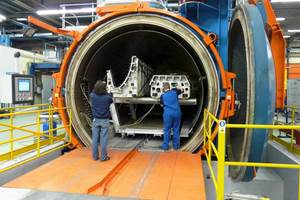Has composites innovation reached "the stall?"
Columnist Dale Brosius reflects that composites innovation, like meat partway through the smoking process, has reached a temporary stalling point.
When I am home, I fire up the grill at least once per month, even during the winter — and multiple times per week during the summer. Sometimes it’s a quick steak or salmon on the gas grill, and other times it’s cooking on my ceramic Big Green Egg smoker using the “low and slow” approach at temperatures between 225°F and 275°F. In fact, I outlined this column while I had a whole chicken cooking away in the Egg, making the main course for a Thursday dinner. I don’t use the smoker only in the summer months, though — I also make turkey in November and pastrami in March. And once you’ve had smoked prime rib for Christmas dinner, you’ll never want to roast it in the oven again. Trust me, it’s that good.
I grew up in Texas, where barbecue is a tradition and beef brisket is king. I’ve also traveled enough to appreciate smoked pulled pork shoulder. Both meats require a whole day to properly prepare, so about six to 10 weekends each year I smoke either a brisket or a couple of pork shoulders. Both cook at 225°F, the lower end of the smoking range, so they go on early in the morning. I insert a couple of temperature probes (just like thermocouples in curing composites), with a goal to hit about 203°F as the finish temperature before pulling the meat off to rest before slicing or shredding.
Once these big hunks of meat go on the smoker, they start to heat up internally at a rate that suggests they’ll be done way before dinner. But somewhere around the four- to six-hour mark, when the internal temperature reaches 150 to 170°F, the temperature stops climbing. And sits there. For hours. For those new to this phenomenon, panic starts to set in. Will this get done to feed the hungry group I invited over for dinner tonight?
This point in the cook is called “the stall,” and there are multiple theories about what is happening, but the most scientific explanation is that the meat is going through evaporative cooling, losing moisture, and indeed, at some point in time, the internal temperature will resume its rise to the desired endpoint. Some purists insist on waiting it out (which could make total cook times more than 12 hours), but I, as well as many competition cooks, rely on what is called the “Texas crutch.” After the meat hits the stall, and has seen smoke for about six hours, it has built a good crust, or “bark,” so we wrap the shoulder or brisket tightly in aluminum foil and return it to the smoker. Shortly, the magic happens, and in about two to three hours, you reach completion. The foil traps the moisture, creating a braising fluid, and ensures a succulent, melt-in-your-mouth outcome. And happy dinner guests!
So, aside from the aforementioned use of thermocouples, what does all this barbecue talk have to do with composites? Fair question. Frankly, after years of rapid improvements in composites manufacturing technology, the composites industry seems to have hit its own version of “the stall.” Thermoset curing times are significantly lower than when BMW introduced the carbon fiber-intensive i3 and i8 in 2013, yet no other global automotive OEMs have followed suit, and none appear to be on the verge. Injection overmolding and stamping with thermoplastics have matured significantly as well, but this technology is not yet widespread. We have multiple processes with the capability of producing 100,000 to 200,000 parts per year from a single mold, but where are the high-volume applications?
It’s not just automotive. In aerospace, we have new technology to infuse and cure large airfoils outside the autoclave, and we’ve seen plenty of innovations to speed fabrication of thermoset and thermoplastic fuselage structures. Such technologies may allow for production of 60-100 single aisle aircraft per month, but Boeing and Airbus seem nowhere close to announcing composites-intensive replacements for the 737 and A320 models.
Across the spectrum, we have improved the techno-economic competitiveness of composites and through modest volume applications, continue to see industry growth. Just not the big game-changing quantities that always seem to be “right around the corner.” Like the barbecue purists, we can simply keep fueling the fire, patiently waiting for the outcomes we know should eventually come. Or, even better, can we find a composites version (or versions) of the Texas crutch and get there much sooner?
Related Content
Advanced autoclaves, ovens provide efficiency, precision and intelligent control
CAMX 2025: Olmar is highlighting its next-gen autoclaves and industrial ovens for composites curing to improve throughput, scale production and achieve tighter quality control.
Read MorePlataine unveils AI-based autoclave scheduling optimization tool
The Autoclave Scheduler is designed to increase autoclave throughput, save operational costs and energy, and contribute to sustainable composite manufacturing.
Read MoreIndustrial curing autoclaves with advanced control systems
CAMX 2025: Turnkey Akarmak autoclaves support various composite curing needs with enhanced process control, international specification compliance and optimal heat distribution.
Read MorePlant tour: Airbus, Illescas, Spain
Airbus’ Illescas facility, featuring highly automated composites processes for the A350 lower wing cover and one-piece Section 19 fuselage barrels, works toward production ramp-ups and next-generation aircraft.
Read MoreRead Next
Ultrasonic welding for in-space manufacturing of CFRTP
Agile Ultrasonics and NASA trial robotic-compatible carbon fiber-reinforced thermoplastic ultrasonic welding technology for space structures.
Read MoreCeramic matrix composites: Faster, cheaper, higher temperature
New players proliferate, increasing CMC materials and manufacturing capacity, novel processes and automation to meet demand for higher part volumes and performance.
Read MoreNext-gen fan blades: Hybrid twin RTM, printed sensors, laser shock disassembly
MORPHO project demonstrates blade with 20% faster RTM cure cycle, uses AI-based monitoring for improved maintenance/life cycle management and proves laser shock disassembly for recycling.
Read More











